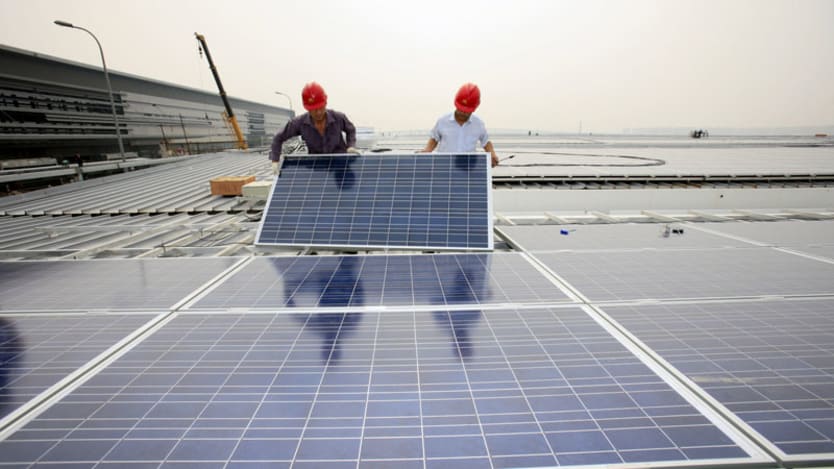
As international climate talks in Bonn wrap up, it’s important to realize just how much the world has been whipsawed in less than two years. In December 2015, the landmark Paris Agreement charted a course to address our changing climate. Then, in June 2017, U.S. President Donald Trump announced his intention to pull the United States out of that agreement. Now, many around the world are looking to see who will take up climate leadership. Increasingly, they are looking to China.
Signs of China taking meaningful action on climate have long been evident. China’s economy has already entered a “new normal,” featuring more moderate economic growth, a greater focus on the quality of growth, and a move away from heavy manufacturing. But a new study points to a potentially worrisome trend: China’s projected emissions growth rate of 3.5 percent in 2017, after two years of decline. This coincides with a surge in global emissions, as well. The increase in China is mainly due to more coal consumption.
The $3.1 billion South-South Climate Cooperation Fund aims to mitigate the impacts of climate change across the developing world. Three years on, some 40 projects in Africa, Asia and Latin America have been approved. But with little public information, much about the ambitious fund remains a question mark and many are eagerly awaiting to see what the superpower could do.
Most experts don’t expect China’s coal consumption to reach its record level from 2013, and there are reasons to believe the increase may be short lived.
China clearly sees climate change as a problem it needs to tackle head-on for health, energy security, and economic reasons. But this is no easy task. It makes sense to examine where China has made progress and look for signals on what to expect in the year ahead.
Cutting industrial energy consumption
China’s industrial sector has underpinned its modern economic development. But in March, at the National People’s Congress, Premier Li Keqiang emphasized the need to cut excess production capacity, including carbon-intensive coal and steel production. China is expected to cut steel production by 50 million tons and coal production by 150 million tons this year, while phasing out or halting construction of new coal-fired power plants.
This is part of China’s push to curb industrial energy consumption, which accounts for more than 70 percent of its total energy consumption. Most of that falls in six energy-intensive sub-sectors: steel, cement, petroleum, chemicals, mineral manufacturing, and industries related to power generation. China’s 13th Five Year Plan, which runs through 2020, specifies a 15 percent reduction in energy consumption intensity and an 18 percent drop in carbon dioxide emissions intensity, while boosting forest cover to more than 23 percent of total land area.
If these targets are met, China will make significant progress toward its commitments under the Paris Agreement to peak carbon dioxide emissions in 2030 or sooner.
Increasing renewable energy
China recognizes that cutting energy consumption alone won’t take it far enough. It also needs to shift to more renewable energy. The share of coal in China’s energy mix has dropped nearly 9 percent between 2005 and 2015, while non-fossil power generation has nearly tripled. The country has a burgeoning solar power sector — installed solar power capacity increased by nearly 82 percent last year to bring the total solar capacity to more than 77 gigawatts, enough to power about 6 million U.S. homes for a year. Strikingly, one way China is expanding its solar capacity is by building solar panels on abandoned coal mines. One such project in Shanxi province covers 160 hectares and can produce enough electricity to power 30,000 homes.
It will be important to see if China increases its investment in renewable energy in the coming year and whether it will tackle the growing waste of renewable energy that comes from poor coordination and distribution of renewable energy projects.
Launching a national emissions trading program
China has been moving forward with putting a modest price on carbon. Starting in 2013, China began to pilot emissions trading programs in seven regions. To date, these pilots have traded about 197 million tons of carbon dioxide that is worth about 4.5 billion yuan ($678 million). The volume of carbon dioxide traded is about equivalent to the annual emissions of Colombia. China has been moving toward launching its national trading system this year. China’s top climate official said in Bonn that preparations are “basically complete,” and the launch date will be announced after it goes through the final approval process.
China has made progress as a climate leader in recent years. Now, we’ll see if China will enhance its national climate commitment for 2020, which all countries are expected to do under the Paris Agreement. We will also watch to see if Chinese leadership extends beyond its borders, including reconsidering support of high-carbon energy infrastructure in other countries.
Given the leadership void on climate left by the U.S. administration, China has a unique opportunity to step forward on the global stage. The big question is whether China takes on this role and if it steers the world to achieve the vision of the Paris Agreement.
Read more Devex coverage on climate change.









